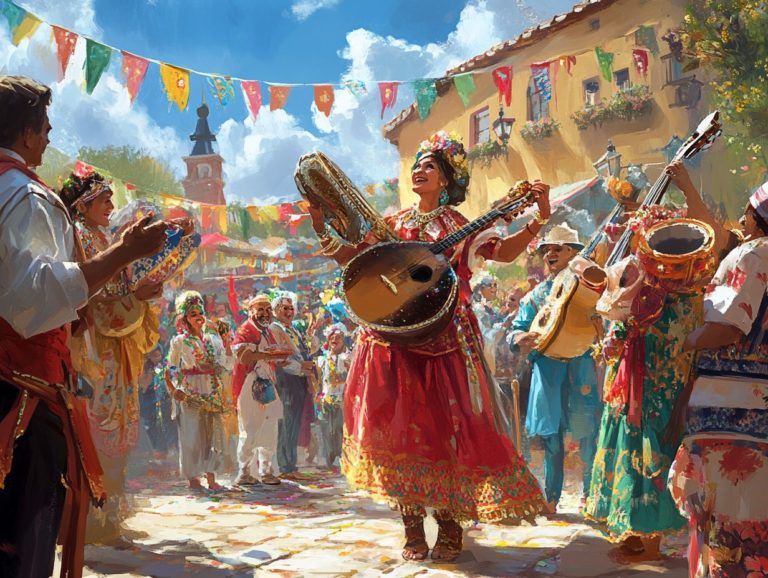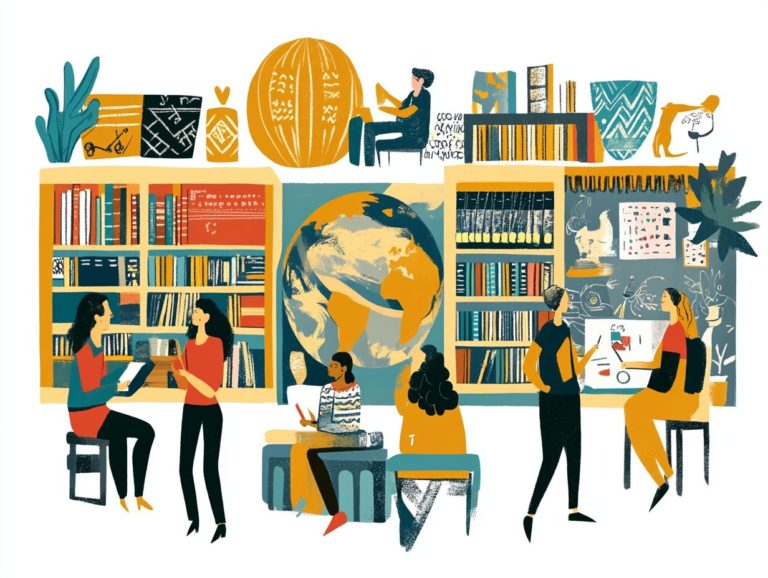cultural insights into regional language variations
Regional languages serve as more than mere instruments of communication; they reflect cultural identity and community heritage.
This exploration delves into intriguing factors that shape variations in regional languages, influenced by geography, history, and social dynamics. It presents compelling case studies that illuminate these differences and examines the strong effects they have on communication and personal identity.
It highlights essential efforts to preserve and celebrate these unique linguistic traditions. Join us on an exciting journey to explore the vibrant world of regional languages and their unique beauty!
Contents
- Key Takeaways:
- Defining Regional Languages
- Factors Influencing Regional Language Variations
- Examples of Regional Language Variations
- Impact of Regional Language Variations
- Preserving and Celebrating Regional Language Variations
- Frequently Asked Questions
- What do we mean by cultural insights in regional language variations?
- How do cultural insights into regional language variations develop?
- Why is it important to understand cultural insights into regional language variations?
- How can cultural insights into regional language variations impact business?
- What are some common examples of regional language variations influenced by culture?
- Can cultural insights into regional language variations change over time?
Key Takeaways:

Regional language variations are influenced by geography, history, and social and cultural factors. These variations significantly impact communication and identity. There are efforts and initiatives in place to preserve and celebrate regional language variations.
Defining Regional Languages
Regional languages are vital for grasping linguistic diversity and embody cultural distinctions within various communities. They include dialects, regional variations, and unique vocabulary, grammar, and pronunciation shaped by historical events, geographical contexts, and ethnic influences.
In places like the United States, the United Kingdom, and Australia, these languages contribute to local identities and promote effective communication.
As a language learner, appreciating these regional nuances deepens your understanding of English in its various forms, enriching your linguistic heritage and cultural perspective.
Factors Influencing Regional Language Variations
Several factors, including geography and history, significantly influence regional language variations, shaping the evolution and interaction of dialects over time.
Geographical boundaries often determine accessibility and contact between language communities, creating unique linguistic landscapes that reflect each group’s cultural heritage.
Beyond these physical barriers, historical influences play a pivotal role in language evolution. Past migrations and social changes leave lasting marks on vocabulary, grammar, and pronunciation, enriching the tapestry of language you encounter.
Geography and History
Geography and history are fundamental elements that shape dialect boundaries and language evolution within regional languages. The physical landscape often dictates interactions between different communities, while historical events like colonization or migration leave lasting marks on language and dialects.
For example, the mountainous terrain of Wales has played a crucial role in preserving the Welsh language, even amid pressures from English-speaking communities. Similarly, the historical context of the Appalachian region in the United States has led to unique dialects influenced by early Scottish-Irish settlers, illustrating how geographic isolation can foster distinct linguistic traits.
The impact of colonization is vividly evident in the Caribbean, where the mingling of indigenous, African, and European languages has birthed creole languages, which develop from the mixing of different languages and reflect the islands’ intricate histories.
In essence, the interplay between physical landscapes and historical narratives continuously shapes diverse dialectical areas, reshaping language and identity with every passing generation.
Social and Cultural Factors

Social and cultural factors greatly affect regional language variations. They shape how you and others from different ethnic groups and social classes communicate.
The nuances in language reflect the values and beliefs of your community. Language is a vital part of its social fabric.
Urban dialects often emerge from the vibrant mix of diverse backgrounds. Here, slang and colloquial phrases thrive among the youth.
Cultural practices, like storytelling, can nurture unique language traits. These traits set one group apart from another.
Your social class also influences language use. People from different economic backgrounds often adopt distinct vocabularies and speech patterns.
For example, working-class individuals may use region-specific slang, while those from upper-class backgrounds prefer standardized language.
Each group reinforces its identity through these language choices. This creates a rich tapestry of communication that tells a story of belonging and distinction.
Examples of Regional Language Variations
Exploring regional language variations reveals fascinating insights into the diversity of dialects. Each dialect has its unique characteristics across cultures.
Case studies from American, British, and Australian English show how linguistic diversity appears in vocabulary, grammar, and pronunciation. These elements reflect the cultural heritage of each region.
These variations enhance communication and deepen your understanding of the societies that embrace them.
Case Studies of Different Regions
Case studies across regions reveal intricate patterns of dialects linked to American, British, and Australian cultures. These linguistic landscapes reflect the historical and social contexts from which they originate.
For instance, the Southern American dialect includes unique words like “y all” and phrases like “fixin to.” These expressions showcase the region’s communal values and hospitality.
In Britain, Cockney rhyming slang illustrates East Londoners’ cultural identity, highlighting their resilience during economic challenges.
Australian English weaves a delightful tapestry with terms like “arvo” for afternoon and “bikkie” for biscuit. These capture the nation’s relaxed lifestyle and connections to Indigenous roots.
Each example highlights the unique grammar and pronunciation of its dialect while showing how language encapsulates regional culture.
Impact of Regional Language Variations
The impact of regional language variations is profound. They influence how you communicate and shape individual and collective identities within communities.
These variations enrich interpersonal interactions and foster a strong sense of belonging. They also serve as vital markers of cultural identity and heritage.
Dialect nuances weave a rich tapestry of connection, enhancing your understanding of the world around you.
Effects on Communication and Identity

The effects of regional language variations on communication and identity are profound. They shape how one expresses themselves and connects with their community.
Language variation offers unique cultural insights that enrich interactions and cultivate a sense of belonging within diverse social environments. Various dialects influence personal identity and shape collective narratives, illustrating the cultural mix of a region.
For instance, a local dialect in Italy may infuse everyday conversations with humor and warmth. In contrast, a distinct accent in the Southern United States might evoke a strong sense of kinship and familial ties.
These variations breathe life into cultural expressions, such as folk music and storytelling traditions, where specific phrases and pronunciations carry deep meanings. The richness of language diversity enhances social connections, encouraging one to celebrate their heritage while fostering understanding among different communities.
Preserving and Celebrating Regional Language Variations
Preserving and celebrating regional language variations is vital for maintaining the richness of linguistic heritage and cultural diversity in society.
Efforts to foster appreciation for these dialects play a crucial role in ensuring that unique linguistic traits are recognized and valued.
This commitment contributes to a vibrant and diverse cultural tapestry, enhancing the community’s collective identity.
Efforts and Initiatives
Numerous efforts and initiatives aimed at language preservation underscore the significance of regional dialects in safeguarding cultural heritage and enhancing community engagement.
These initiatives manifest in various forms, from educational programs to vibrant local cultural events that celebrate the distinctive qualities of regional languages.
For example, workshops in schools across different communities introduce children to their linguistic heritage through interactive lessons that draw from local folklore and storytelling. Imagine the spark in their eyes as they connect with their roots!
Community theater groups often bring regional dialects to life through performances, allowing residents to engage with their linguistic heritage creatively.
Libraries host language caf s where speakers of different dialects come together, sharing unique phrases and practicing their linguistic skills. This fosters connection and ensures diverse expressions continue to flourish.
Cultural festivals also include programs dedicated to showcasing dialect-specific poetry and literature, opening avenues for a richer appreciation and understanding of the nuances of regional dialects within the broader context of language preservation.
Frequently Asked Questions
What do we mean by cultural insights in regional language variations?

Cultural insights into regional language variations refer to understanding how cultural and social factors influence the language used in different regions, including how to appreciate local dialects in cultural context.
How do cultural insights into regional language variations develop?
Cultural insights into regional language variations develop through studying the history, geography, and societal norms of a particular region, as well as interactions with native speakers.
Why is it important to understand cultural insights into regional language variations?
Understanding cultural insights into regional language variations allows for better communication and cultural awareness, helping to avoid misunderstandings or offense.
How can cultural insights into regional language variations impact business?
Cultural insights into regional language variations can impact business by influencing consumer behavior, marketing strategies, and communication methods in different regions.
What are some common examples of regional language variations influenced by culture?
Common examples of regional language variations influenced by culture include dialects, slang, idioms, and non-verbal communication patterns.
Can cultural insights into regional language variations change over time?
Absolutely! Our understanding of how culture affects language constantly evolves.
This change is driven by cultural shifts, migration, and the influence of globalization.





